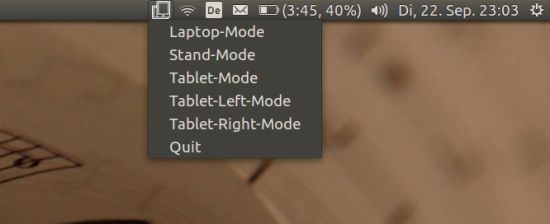
UPDATE APRIL 2017: Canonical will stop the development of Unity and thus the „Screen Rotation Indicator“ is obsolete. It is also no longer needed, since GNOME Desktop supports automatic screen rotation by default (tested with Yoga 3 11). This also really works 1a and is a much better solution 🙂 However for educational purpose the GitHub repository is still there.
I have owned a new toy in the form of a Lenovo Yoga 3 11 for a few months now. The Yoga is a convertible, also called a multimode notebook by Lenovo, where the touchscreen can be folded back 180 degrees. This turns it into a tablet.
From a purely mechanical point of view, this also works excellently. Thus, you have a really extremely light combination of laptop and tablet. There is only one catch – the software. Both under Windows and Linux, the tablet mode is not comparable with an Android or IOS tablet from a usability perspective.
A big problem with Linux distributions is that there is no software from Lenovo for automatic screen rotation. To make up for this shortcoming somewhat, I wrote a Python-based Ubuntu Unity Indicator, which enables the rotation of the screen. At the same time, it also disables or enables the touchpad. There is also a button on the right side of the Lenovo Yoga (intended to lock autorotation under Windows) which can also be used for rotation.
Long story short – here are the required installation steps:
1.) Download file from my GitHub repository and unzip.
2.) Open a terminal and change to the folder of the unzipped file.
~$ cd /path/to/screenrotation-master/
3.) Copy the screenrotation.svg to /usr/share/pixmaps/
~$ sudo cp ./screenrotation.svg /usr/share/pixmaps/
4.) The screenrotation.sh and screenrotation-indicator.py must be copied to /usr/local/bin/
~$ sudo cp ./screenrotation.sh /usr/local/bin<br /> ~$ sudo cp ./screenrotation-indicator.py /usr/local/bin
5.) The last two files copied must be made executable
~$ sudo chmod +x /usr/local/bin/screenrotation-indicator.py<br /> ~$ sudo chmod +x /usr/local/bin/screenrotation.sh
6.) Now screenrotation-indicator.py can be added to the startup programs. To do this „open startup programs“ and click „add“. The name can be freely chosen. Enter as command:
/usr/local/bin/screenrotation-indicator.py
7.) If desired, assign a keyboard shortcut. Under „System settings“ -> „Keyboard“ -> „Keyboard shortcuts“ -> „Own keyboard shortcuts“ a new one can be added with „+“. The name is again freely selectable. The command is:
/usr/local/bin/screenrotation.sh -key
8.) Then click „apply“. One click on the keyboard shortcut, and you can choose your key combination. On a Yoga 3 11, the mentioned button on the right of the device (Super+O) is a good choice.

----- Comments -----
---
Danke für das super Script!
---
Hallo ich habe auch eeinen yoga 3 11 und will früher oder später auf Linux wechseln (dachte an Lubuntu Lts vieleicht auch Linux mint oder zum rummtesten Ubuntu gnome).
Zumindest unter windows gibt es mit dem Gerät Probleme das der Prozessor wilkürlich gedrosselt wird und nicht freigegeben wird bis man den rechner neustartet. Kennst du das Problem? Hast du es auch bei Linux? Gibt es sonstige Probleme die auftreten wenn man Linux auf das Yoga 3 11 installiert? Hast du die Lts Version oder die aktuelste Version von Ubuntu drauf (ich würde Lts bevorzugen)? Dein Script läuft nur unter Unity?
Bitte per Mail bescheit geben wenn du ne Antwort hast.
---
@ frage nase: Die Drosselung des Prozessors ist unter Windows und Linux normal. Damit hält der Core-M seine TDP von 4,5 Watt … sprich er drosselt bevor er zu heiß wird und ermöglicht somit das lüfterlose Design. Jedoch nicht dauerhaft. Wenn die Temperatur sinkt, erhöht sich der Takt wieder – zumindest unter Linux. Unter Windows hatte ich das Gerät nicht lange benutzt. Ich benutze Ubuntu 15.10. Versionen vor 15.10 haben keine passende Wlan Firmware/Treiber (Lösung:Siehe anderen Beitrag). Sonst eigentlich keine Probleme. Das Script inkl. screenrotation-indicator.py läuft nur mit Unity. Der Teil screenrotation.sh und das belegen eines Buttons müsste auch unter LXDE oder Gnome gehen.
---
Hallo,
ich habe Ubuntu 16.04 auf einem Dell Venue 11 Pro 7139 installiert und nach einigem Basteln auch den Touch-Screen zum Laufen bekommen (die Lösung war die Installation eines neueren Mainline-Kernels). Die Rotation habe ich über xrandr mit Tastenkombinationen gelöst. Deine Lösung über den Indicator ist natürlich um Klassen besser und ich danke dir dafür. Leider funktioniert jedoch die automatische Rotation nicht, obwohl alle Systemvoraussetzungen gegeben scheinen. Autorotate.sh meldet auch nichts, wenn ich es im Terminal starte. Hast du einen Tipp, woran es liegen könnte?
Gruß
Uwe
---
Hallo, das Skript unterstützt aktuell die automatische Rotation nur bei einem „Lenovo Yoga 3 11“. Hintergrund ist, das bei deinem „Dell Venue 11 Pro 7139“ andere Sensoren Verwendung finden. Gruß Philipp
---
Wofür sind den eigentlich all die anderen Files in screenrotation-master gut? Wo soll man die ablegen?
---
Ich ziehe meine Frage zurück – steht doch alles bei GitHub… dann kann ich’s ja mal auf meinem Yoga910 probieren.
---
Ich habe yoga 3 pro 1370 mit Ubuntu 17.04. Kan deine løsung mit dies machen?
---
Ich kann nur empfehlen, auf Ubuntu mit Gnome zu wechseln. Dies ist für 2 in 1 Geräte mitlerweile die bessere Lösung. Ob dein Sensor schon Treiberunterstützung hat, kann ich leider nicht sagen.
---
Bevor ich wieder zu Ubuntu wechsle, geh ich doch lieber wieder zu OS/2 zurück…
---
Yoga 700 rotiert inzwischen von selbst mit Ubuntu 17.04 und 17.10, aber zZt. leider nur auf Gnome.
---
Gnome bietet eine sehr gute Unterstützung für Convertibles und 2 in 1 Geräte. Die Wahrscheinlichkeit für weitere Verbesserungen ist bei Gnome sicher auch am höchsten. Mit Gnome 3.28 soll es z.Bsp. ein neues Onscreen-Keyboard geben ( https://wiki.gnome.org/ReleasePlanning/FeaturePlans ). Daher ist Gnome in dem Bereich auch die beste Entscheidung ….